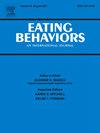The role of hyper-palatable foods in energy intake measured using mobile food photography methodology
IF 2.4
3区 医学
Q2 PSYCHIATRY
引用次数: 0
Abstract
Objective
Hyper-palatable foods (HPF) contain nutrient combinations that are hypothesized to maximize their rewarding effects during consumption. Due to their strong reinforcing properties, HPF are hypothesized to lead to greater energy intake within a meal. However, this premise has not been tested in free-living conditions. The current study examined the association between within-meal HPF intake and 1) measured energy intake and 2) self-reported overeating, assessed within eating occasions using smartphone-based food photography methodology.
Methods
A total of 29 participants reported food intake and eating experiences (N=345 total eating occasions) in real-time for 4 days using smartphone-based food photography methodology. HPF were identified using a standardized definition. Bayesian multilevel modeling was conducted to investigate the within-person effects of proportional calorie intake from HPF (%kcal from HPF) on total energy intake and subjective overeating. Pre-meal hunger and proportional energy intake from high energy dense (HED) foods were included as covariates.
Results
Results revealed that when participants consumed more %kcal from HPF than their average, they consumed greater total energy during eating occasions, even when controlling for pre-meal hunger and %kcal from HED foods (median β = 0.09, 95% HDI [0.02, 0.16], pd. = 99.56%). Additionally, consuming more %kcal from HPF than average was associated with greater eating despite feeling full, when controlling covariates (median β = 0.15, 95% HDI [-0.02, 0.34], pd = 96.45%).
Conclusions
The findings supported the premise that HPF themselves may yield greater energy intake and eating despite satiation, measured in real-time and free-living conditions.
利用移动食品摄影方法测量超美味食品在能量摄入中的作用
目的超美味食物(HPF)含有营养组合,假设在食用过程中最大化其奖励效果。由于其强大的增强特性,高强度食物被假设会导致在一餐中摄入更多的能量。然而,这个前提还没有在自由生活的条件下得到检验。目前的研究调查了餐内高强度pf摄入与1)测量的能量摄入和2)自我报告的暴饮暴食之间的关系,使用基于智能手机的食物摄影方法在进食场合进行评估。方法29名参与者使用基于智能手机的食物摄影方法,在4天内实时报告食物摄入和饮食经历(N=345次进食)。使用标准化定义确定HPF。贝叶斯多层模型研究了从高强度食物中摄入的卡路里比例(从高强度食物中摄入的卡路里百分比)对总能量摄入和主观暴饮暴食的影响。餐前饥饿感和高能量密度(HED)食物的比例能量摄入作为协变量。结果显示,当参与者从高热量食物中摄入的%kcal高于平均水平时,即使在控制餐前饥饿感和从高热量食物中摄入的%kcal时,他们在进食时消耗的总能量也更高(中位数β = 0.09, 95% HDI [0.02, 0.16], pd)。= 99.56%)。此外,当控制协变量(中位数β = 0.15, 95% HDI [-0.02, 0.34], pd = 96.45%)时,从HPF中摄入的卡路里比平均水平多%与更大的进食量相关。研究结果支持了这样一个前提,即在实时和自由生活条件下,HPF本身可能会产生更多的能量摄入和进食,尽管有饱腹感。
本文章由计算机程序翻译,如有差异,请以英文原文为准。
求助全文
约1分钟内获得全文
求助全文
来源期刊

Eating behaviors
Multiple-
CiteScore
4.20
自引率
3.60%
发文量
65
审稿时长
60 days
期刊介绍:
Eating Behaviors is an international peer-reviewed scientific journal publishing human research on the etiology, prevention, and treatment of obesity, binge eating, and eating disorders in adults and children. Studies related to the promotion of healthy eating patterns to treat or prevent medical conditions (e.g., hypertension, diabetes mellitus, cancer) are also acceptable. Two types of manuscripts are encouraged: (1) Descriptive studies establishing functional relationships between eating behaviors and social, cognitive, environmental, attitudinal, emotional or biochemical factors; (2) Clinical outcome research evaluating the efficacy of prevention or treatment protocols.
 求助内容:
求助内容: 应助结果提醒方式:
应助结果提醒方式:


